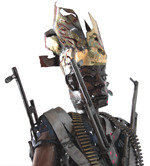Expanding Views of Africa
dal 2/8/2011 al 2/8/2012
Segnalato da
Cantor Arts Center, Margaret Whitehorn
2/8/2011
Expanding Views of Africa
Cantor Arts Center, Stanford
This enlarged and enhanced reinstallation, which includes 200 works from the collection and key loans, broadens conventional views of African art, from ancient cultures before the dynasties of the Egyptian Pharaohs to contemporary artists.

Stanford, California — Cantor Arts Center at Stanford University announces "Expanding Views of Africa," opening August 3, 2011. This enlarged and enhanced reinstallation, which includes 200 works from the collection and key loans, broadens conventional views of African art, from ancient cultures before the dynasties of the Egyptian Pharaohs to contemporary artists. Admission to the Cantor Arts Center and to the exhibition is free.
"The art of Africa dates from the beginning of humanity to the present, and African art expresses ideas about humanity that are held in common with peoples all over the world and throughout time," said Barbara Thompson, Ph.D., Phyllis Wattis Curator of the Arts of Africa and the Americas. "I am excited about this opportunity to introduce our visitors to a new way of considering African art and culture, in its historical depth and diversity. We are featuring a greater range of media and chronological, geographic, and thematic representation than ever before. The objects now on view illustrate the unique nature of the Cantor Arts Center's African collection and demonstrate our new strategies in collection development and display."
Before entering the African galleries, a niche off the lobby highlights a single object: a full-sized bush buffalo costume with mask from the Nunuma culture of Burkina Faso. Once in the first gallery, visitors encounter contemporary works made in a variety of media from the 1950s to the present, by artists living in Africa and the Diaspora. The next space presents African arts from the 16th to the mid-20th century. The final gallery features the oldest African arts in museum collections, ranging from pre-dynastic Egypt to 15th-century sub-Saharan cultures. The earliest antiquities on view, pottery from approximately 4000–3100 BCE, predate the emergence of a single powerful leader and the unification of Egypt under the Pharaohs.
Thompson uses a thematic approach to correlate objects throughout the ancient, historic, and contemporary sections of the reinstallation. The theme "Fashioning the Body/ Defining the Self" includes body adornment used to define gender, cultural affinity, age, and social status, such as contemporary Tuareg jewelry, 19th-century Nguni beadwork, and an ancient Egyptian necklace. "Economies and Exchanges in Africa and Beyond" is exemplified by ancient Egyptian trade objects, goldweights from the historic period, and a contemporary abstracted painting of a busy market. "Moments of Transformation" includes an Egyptian mummy mask, from the 7th–6th century BCE, which aids in transitioning to the afterlife, and a 19th-century bocio figure used in the Vodoun religion of the Fon peoples of the Republic of Benin. Bocio figures help to bring about protection, wellbeing, wisdom, and balance. The Vodoun religion spread throughout West Africa and to the Americas with the trans-Atlantic slave trade, a troubled history that Beninese artist Gérard Quenum recalls in his "Night Watchman," a sculpture from 2004 that promotes thought and social commentary.
Works from 5000 Years of African Art, Culture, and Beliefs on View in the Enhanced Galleries for African Art
Expanding Views of Africa
Image: Sokari Douglas Camp
Accessories Worn in the Delta (detail), 2006. Steel, wood, and gold leaf. Museum purchase made possible by the Phyllis Wattis Program Fund, 2010.80
Opens August 3, 2011, then continues indefinitely
Cantor Arts Center
Stanford campus, Lomita Drive at Museum Way - Stanford
Hours opening: Wednesday – Sunday 11 am – 5 pm
Thursday 11 am – 8 pm
Admission Free



